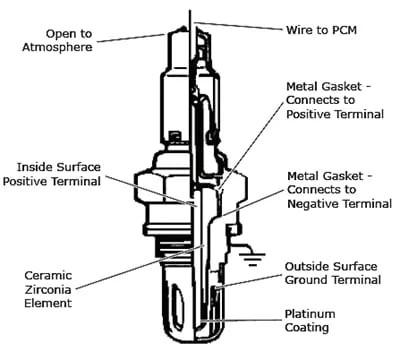Every vehicle on the road produces exhaust gases as a byproduct of its engine’s combustion process. Managing these emissions efficiently and effectively is the crucial job of the exhaust system. Within this system, the oxygen sensor, often referred to as the O2 sensor, stands out as a critical component. But what exactly is the 02 Sensor Purpose? This sensor plays a vital role in monitoring the exhaust gases and ensuring your engine runs cleanly and efficiently.
 O2 Sensor Function in Exhaust System
O2 Sensor Function in Exhaust System
Decoding the 02 Sensor Purpose: How It Works
The primary 02 sensor purpose is to measure the amount of unburned oxygen present in the exhaust gases after combustion. This measurement is crucial because it provides real-time data to the vehicle’s Electronic Control Unit (ECU), the car’s central computer. The ECU uses this information to fine-tune the air-to-fuel ratio, which is the mixture of air and fuel that enters the engine’s cylinders.
Maintaining the optimal air-to-fuel ratio is paramount for several reasons:
- Efficient Combustion: A precise ratio ensures that fuel is burned completely and efficiently, maximizing engine power and fuel economy.
- Emissions Control: The right mixture minimizes the production of harmful pollutants like hydrocarbons, carbon monoxide, and nitrogen oxides.
- Catalytic Converter Function: The catalytic converter, another key component in the exhaust system, relies on the correct air-to-fuel ratio to function effectively and further reduce emissions.
O2 sensors became standard in vehicles in 1981 due to growing environmental concerns and regulations. Modern vehicles, especially those manufactured after 1996, often have multiple oxygen sensors. Typically, there are upstream and downstream sensors. The upstream sensor, located before the catalytic converter, measures the air-fuel ratio going into the converter. The downstream sensor, positioned after the catalytic converter, monitors its efficiency. This sophisticated system provides even more precise control over emissions and engine performance.
Location of the O2 Sensor
Finding the oxygen sensor is relatively straightforward. It is typically located in the exhaust manifold, which is attached directly to the engine. The exhaust manifold’s purpose is to collect the exhaust gases from the engine cylinders. The O2 sensor is strategically placed here to get an accurate reading of the exhaust gas composition right after it leaves the engine.
Recognizing a Failing O2 Sensor: Warning Signs
While O2 sensors are designed to be durable, they can wear out over time due to exposure to high temperatures and exhaust gases. A malfunctioning oxygen sensor can disrupt the ECU’s ability to regulate the air-to-fuel ratio, leading to various engine performance problems. Being aware of the warning signs of a failing O2 sensor is important for maintaining your vehicle’s health:
- Decreased Gas Mileage: When an O2 sensor fails, it might send incorrect readings to the ECU, often causing the system to inject more fuel than necessary. This rich fuel mixture results in wasted fuel and a noticeable decrease in fuel economy.
- Engine Misfiring and Rough Idling: An improper air-to-fuel ratio can lead to incomplete combustion, causing the engine to misfire. This can manifest as rough idling, where the engine vibrates or runs unevenly, and can be accompanied by the check engine light illuminating on the dashboard.
- Reduced Engine Power: If the air-fuel mixture is not optimal (either too rich or too lean), the engine will not be able to produce its full power. You might experience difficulty accelerating, sluggish performance, or a noticeable drop in overall engine power.
- Rotten Egg Smell: A sulfurous “rotten egg” smell emanating from the exhaust can be another indicator of a failing O2 sensor. This smell is often caused by excess fuel in the exhaust system overloading the catalytic converter, which then produces hydrogen sulfide.
If you observe any of these symptoms, particularly in combination with a check engine light, it’s crucial to have your vehicle inspected by a qualified technician. Diagnosing and replacing a faulty O2 sensor promptly can prevent more serious engine damage and ensure your vehicle operates efficiently and cleanly.
O2 Sensor FAQs
How does an O2 sensor precisely measure oxygen levels?
Modern O2 sensors are sophisticated electrochemical devices. They typically use a ceramic sensing element, often made of zirconia or titania, that generates a voltage signal based on the difference in oxygen concentration between the exhaust gas and the outside air. This voltage signal is then interpreted by the ECU to adjust the air-fuel mixture.
Why are O2 sensors mandatory in modern vehicles?
O2 sensors are mandated due to stringent emissions regulations designed to protect air quality and public health. By ensuring optimal combustion and catalytic converter function, O2 sensors play a critical role in reducing harmful pollutants released into the atmosphere.
What other issues can mimic faulty O2 sensor symptoms?
Several other engine problems can present symptoms similar to a failing O2 sensor. These include issues with:
- Mass Air Flow (MAF) sensor: This sensor measures the amount of air entering the engine and its malfunction can also lead to incorrect air-fuel ratios.
- Fuel injectors: Leaking or clogged fuel injectors can disrupt fuel delivery and cause misfires and poor fuel economy.
- Vacuum leaks: Unmetered air entering the engine through vacuum leaks can lean out the air-fuel mixture and cause rough idling and performance issues.
Therefore, professional diagnosis is essential to accurately pinpoint the root cause of engine problems.
Maintaining Optimal Engine Performance
Understanding the 02 sensor purpose highlights its importance in maintaining your vehicle’s engine performance, fuel efficiency, and emissions control. Regular vehicle maintenance and prompt attention to warning signs can help ensure the longevity and effectiveness of your O2 sensor and the overall health of your vehicle. If you suspect an issue with your O2 sensor, seeking professional diagnosis and repair is always recommended to keep your car running smoothly and environmentally responsibly.